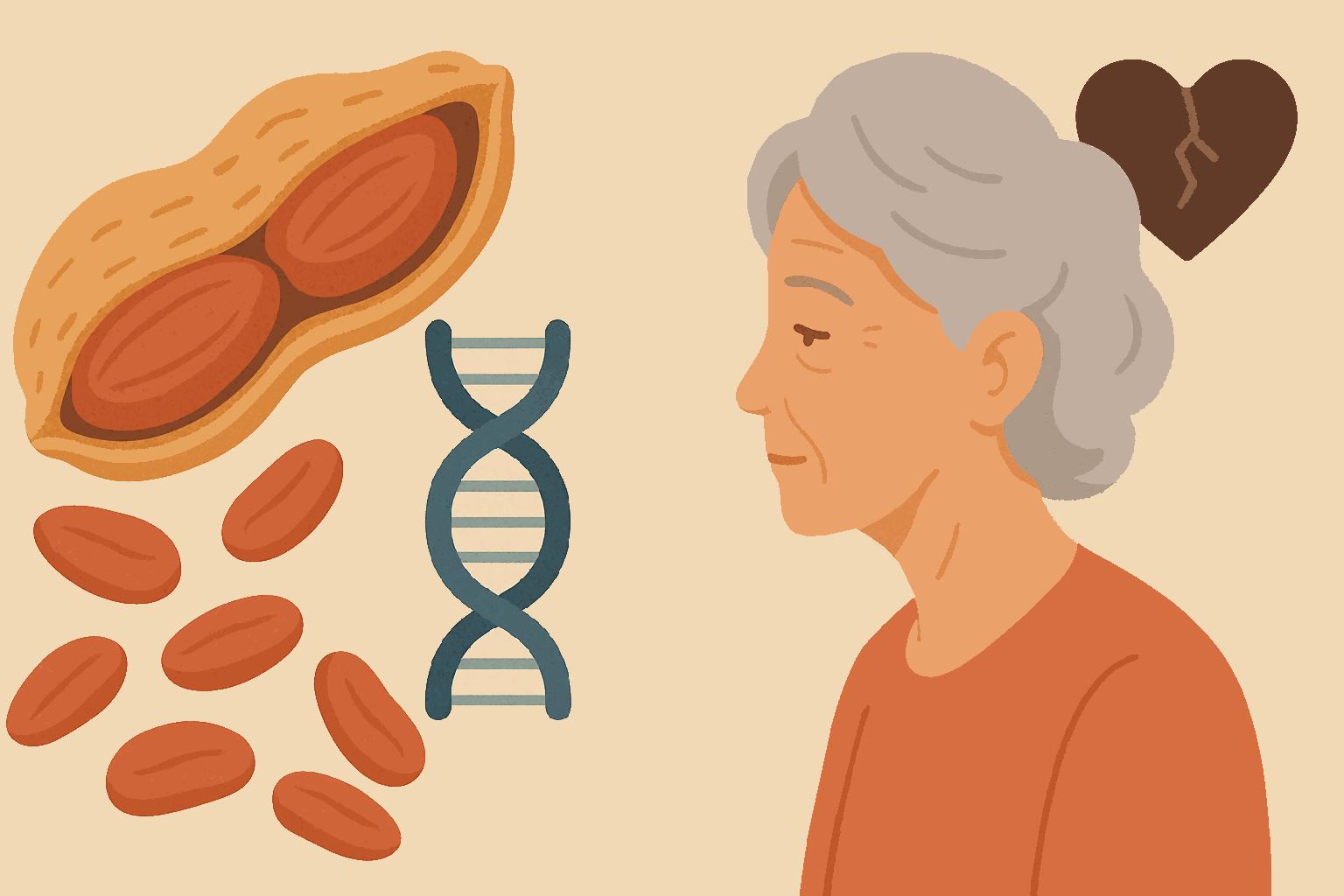
Glycine: A Promising Amino Acid for Longevity and Healthy Aging
- Marcus Reed
- Supplements , Health , Nutrition
- May 13, 2025
Table of Contents
Fast Facts: Glycine & Longevity (TL;DR)
- Key Amino Acid: Glycine, a simple amino acid, shows significant promise in promoting longevity and healthy aging.
- Lifespan Extension: Animal studies demonstrate that glycine supplementation can extend lifespan, an effect partly attributed to mimicking methionine restriction.
- mTOR Regulation: Glycine helps regulate the mTOR pathway, a critical controller of cell growth and aging, by reducing levels of mTOR activators like SAM.
- Autophagy Boost: It supports autophagy, the cellular cleanup process that removes damaged components, contributing to cellular rejuvenation.
- Antioxidant Power: Glycine is a crucial building block for glutathione, the body’s master antioxidant, protecting cells from age-related oxidative stress.
- Dietary Sources: Found in protein-rich foods like meat, fish, dairy, bone broth, gelatin, and legumes.
- More Research Needed: While promising, especially from animal studies, more human research is essential to fully understand glycine’s role in human longevity.
Glycine: Unlocking a Simple Amino Acid’s Potential for Longevity
In the quest for a longer, healthier life, scientific research continually uncovers fascinating insights into how our bodies age and what we can do to influence this process. Among the myriad of compounds being studied, a simple amino acid, glycine, is capturing significant attention from researchers and health enthusiasts alike. While it may be the smallest of the amino acids, its potential impact on longevity and healthy aging appears to be anything but diminutive.
Glycine is a non-essential amino acid, meaning our bodies can typically synthesize it. It serves as a fundamental building block for proteins and plays critical roles in various physiological processes, including neurotransmission and the synthesis of other vital compounds like creatine and porphyrins. But beyond these foundational functions, emerging evidence suggests glycine may hold a key to slowing aspects of the aging process. This article delves into the science behind glycine’s promise for longevity, exploring its mechanisms of action and what current research signifies for those seeking to optimize their healthspan.
Glycine and Lifespan: What the Scientific Evidence Reveals
The buzz around glycine and longevity isn’t unfounded. It’s rooted in compelling scientific research, primarily from animal studies. These studies provide a crucial window into how glycine might influence lifespan:
- Mimicking Methionine Restriction: A landmark study published in 2011 found that dietary glycine supplementation extended the lifespan of Fisher 344 rats. Notably, the researchers suggested that glycine’s effects mimicked those of dietary methionine restriction, a well-established strategy for extending lifespan in various species (Brind et al., 2011). Methionine is an essential amino acid, and reducing its intake has consistently shown longevity benefits.
- Lifespan Extension in Other Models: Further supporting these findings, a 2019 study demonstrated that glycine supplementation extended the lifespan of Caenorhabditis elegans (a type of roundworm commonly used in aging research) by approximately 5% (Liu et al., 2019).
While these animal studies are highly encouraging, it’s important to underscore that translating these findings directly to human longevity requires further extensive research. Human physiology is more complex, and many factors influence our lifespan. However, these studies provide a strong rationale for continued investigation into how glycine benefits healthy aging in humans.
Decoding the Mechanisms: How Glycine May Extend Healthspan
The potential of glycine to promote longevity isn’t attributed to a single action but rather a combination of beneficial effects on key cellular pathways and processes implicated in aging.
The mTOR Connection: A Master Regulator of Aging
Central to glycine’s anti-aging potential is its influence on the mTOR (mammalian target of rapamycin) pathway. mTOR is a protein kinase that acts as a master regulator of cell growth, proliferation, metabolism, and survival (Johnson et al., 2013). While essential for development and normal bodily function, chronic overactivation of the mTOR pathway is strongly associated with accelerated aging and various age-related diseases, including cancer and metabolic disorders.
So, how does glycine come into play? Glycine appears to help downregulate mTOR activity. One primary mechanism involves its role in methyl group metabolism. The enzyme Glycine N-methyltransferase (GNMT) utilizes glycine to convert S-adenosylmethionine (SAM) into sarcosine. SAM is a universal methyl donor and a potent activator of mTOR. By facilitating the conversion of SAM, glycine effectively helps reduce SAM levels. Lower SAM levels, in turn, lead to decreased methionine levels (as SAM is derived from methionine), both of which contribute to reduced mTOR activation. This action is significant because, as mentioned, restricting methionine intake is a known longevity-promoting intervention (Orentreich et al., 1993).
The “Paradoxical Activation” – A Nuance Explained
It’s worth noting a complexity: some research suggests glycine can, under certain conditions, also weakly activate mTOR. However, the prevailing understanding is that its impact on reducing SAM and methionine levels—thereby dampening overall mTOR signaling—is the more dominant and relevant effect concerning longevity. The net result is a shift towards a state more conducive to cellular maintenance and stress resistance, hallmarks of healthy aging.
Autophagy Activation: Cellular Housekeeping for Longevity
Autophagy, from the Greek words for “self-eating,” is a fundamental cellular cleanup process. It involves the degradation and recycling of damaged or unnecessary cellular components, such as misfolded proteins and worn-out organelles (Madeo et al., 2015). Efficient autophagy is crucial for maintaining cellular health, preventing the accumulation of toxic waste, and promoting longevity.
Glycine metabolism may play a role in stimulating autophagy. As glycine is metabolized, sarcosine (N-methylglycine) is produced (as part of the GNMT reaction discussed earlier). Some evidence suggests that sarcosine can induce autophagy, further contributing to glycine’s potential anti-aging effects by ensuring cells remain “clean” and functional. Glycine and autophagy for cell health is an active area of investigation.
Bolstering Antioxidant Defenses: The Glutathione Story
Oxidative stress, caused by an imbalance between the production of reactive oxygen species (free radicals) and the body’s ability to neutralize them, is a major driver of aging and age-related diseases (López-Otín et al., 2013). Our bodies rely on a sophisticated antioxidant defense system, and at the forefront of this system is glutathione.
Glutathione is often referred to as the body’s “master antioxidant.” Glycine is one of the three amino acid precursors required for glutathione synthesis (the other two being cysteine and glutamic acid) (Linus Pauling Institute, n.d.). As we age, glutathione levels naturally decline, potentially increasing vulnerability to oxidative damage. By providing a key building block for glutathione, glycine glutathione synthesis for antioxidant protection becomes critical. Ensuring adequate glycine availability may help maintain robust glutathione levels, thereby protecting cells from oxidative stress and supporting overall cellular resilience.
Beyond the Core: Other Potential Benefits of Glycine
Glycine’s contributions to healthy aging may extend beyond mTOR, autophagy, and glutathione:
- Improved Sleep Quality: Several human studies have shown that glycine supplementation can improve subjective sleep quality, reduce sleep onset latency (the time it takes to fall asleep), and diminish daytime sleepiness (Yamadera et al., 2007; Bannai & Kawai, 2012). Quality sleep is intrinsically linked to better health, cognitive function, and longevity.
- Collagen Synthesis: Glycine is a primary component of collagen, the most abundant protein in the body, essential for the structure of skin, bones, tendons, and cartilage. Adequate glycine is necessary for maintaining tissue integrity and repair.
- Anti-inflammatory Effects: Chronic inflammation is another hallmark of aging. Some research indicates glycine possesses anti-inflammatory properties, which could further contribute to its health-protective effects (Razak et al., 2017).
Glycine in Your Diet and Supplementation Considerations
Given its importance, ensuring adequate glycine intake is a sensible approach to supporting overall health.
Natural Food Sources of Glycine
Glycine is readily available in many common foods, particularly those rich in protein:
- Meat: Beef, pork, lamb (especially connective tissues)
- Poultry: Chicken, turkey (skin and cartilage are good sources)
- Fish and Seafood
- Bone Broth and Gelatin: These are exceptionally rich sources of glycine due to their collagen content.
- Dairy Products: Milk, cheese, yogurt
- Eggs
- Legumes: Soybeans, beans, lentils
- Seeds and Nuts: Pumpkin seeds, sesame seeds, peanuts
- Certain Vegetables: Spinach, cauliflower
Glycine Supplementation: What to Consider
While the body can produce glycine, and it’s found in many foods, supplementation is an option some individuals explore, particularly given the doses used in some research studies. Glycine supplements are generally considered safe for most people when taken at appropriate doses.
 However, as with any supplement, it’s crucial to:
However, as with any supplement, it’s crucial to:
- Consult a Healthcare Professional: Before starting glycine supplementation (or any new supplement), discuss it with your doctor or a qualified healthcare provider. They can help determine if it’s appropriate for you, considering your individual health status, existing medications, and potential interactions.
- Prioritize a Balanced Diet: Supplements should not replace a healthy, balanced diet rich in whole foods. Aim to obtain nutrients, including glycine, primarily from dietary sources.
- Understand the Research: While research on glycine supplements for longevity is promising, much of the direct lifespan extension data comes from animal models. Human studies have primarily focused on other benefits like sleep or metabolic health (Alves et al., 2019; Mount Sinai, n.d.).
Glycine: A Piece of the Longevity Puzzle
The emerging science on glycine is exciting, positioning this humble amino acid as a noteworthy candidate in the field of longevity research. Its ability to influence fundamental aging pathways like mTOR, support cellular cleanup through autophagy, and bolster antioxidant defenses via glutathione synthesis paints a compelling picture of its potential benefits.
However, it’s essential to view glycine within the broader context of a comprehensive healthy aging strategy. No single supplement or food can be a magic bullet against aging. A holistic approach that includes a nutrient-dense diet, regular physical activity, stress management, adequate sleep, and meaningful social connections remains the cornerstone of promoting a long and vibrant life.
Conclusion: The Promise and Path Ahead for Glycine
Glycine’s journey from a simple building block to a potential modulator of longevity is a testament to the intricate and fascinating nature of biochemistry. The research to date, particularly from animal studies, offers a promising glimpse into how glycine may contribute to extending healthspan and lifespan. Its multifaceted mechanisms—targeting mTOR, boosting autophagy, and enhancing antioxidant capacity—align well with our current understanding of the aging process.
The path ahead requires more robust human clinical trials to fully elucidate glycine’s role in human longevity, establish optimal intake levels for anti-aging benefits, and further explore its long-term safety and efficacy. Nevertheless, ensuring adequate glycine intake through a protein-rich diet, and considering supplementation judiciously under professional guidance, may be a valuable component of an evidence-based approach to healthy aging. As science continues to unravel the complexities of aging, glycine stands out as an amino acid worthy of continued attention and investigation.
Frequently Asked Questions (Q&A)
Q1: What is glycine and why is it important for longevity?
Q2: How does glycine affect the mTOR pathway in relation to aging?
Q3: What are the main dietary sources of glycine?
Q4: Can taking glycine supplements help me live longer?
Q5: Besides mTOR, what other ways might glycine support healthy aging?
Disclaimer
The information provided on BioBrain is intended for educational purposes only and is grounded in science, common sense, and evidence-based medicine. It is not a substitute for professional medical advice, diagnosis, or treatment. Always consult a qualified healthcare provider before making significant changes to your diet, exercise routine, or overall health plan.
References
- Brind, J., Malloy, V., et al. (2011) "Dietary glycine supplementation mimics lifespan extension by dietary methionine restriction in Fisher 344 rats"
- Liu, P. S., Hsieh, Y. C., et al. (2019) "Glycine supplementation extends lifespan of Caenorhabditis elegans"
- Razak, M. A., Begum, P. S., Viswanath, B., & Rajagopal, S. (2017) "Multifarious Beneficial Effect of Nonessential Amino Acid, Glycine: A Review"
- Linus Pauling Institute (n.d.) "Glutathione"
- Johnson, S. C., Rabinovitch, P. S., & Kaeberlein, M. (2013) "mTOR is a key modulator of ageing and age-related disease"
- Yamadera, W., Inagawa, K., Chiba, S., Bannai, M., Takahashi, M., & Nakayama, K. (2007) "Glycine ingestion improves subjective sleep quality in human volunteers, correlating with polysomnographic changes"
- Mount Sinai (n.d.) "Glycine"
- Alves, A., Bassot, A., Bulteau, A. L., Pirola, L., & Morio, B. (2019) "Glycine Metabolism and Its Alterations in Obesity and Metabolic Diseases"
- Madeo, F., Zimmermann, A., Maiuri, M. C., & Kroemer, G. (2015) "Essential role for autophagy in life span extension"
- López-Otín, C., Blasco, M. A., Partridge, L., Serrano, M., & Kroemer, G. (2013) "The Hallmarks of Aging"
- Orentreich, N., Matias, J. R., DeFelice, A., & Zimmerman, J. A. (1993) "Low methionine ingestion by rats extends life span"
- Bannai, M., & Kawai, N. (2012) "New therapeutic strategy for amino acid medicine: glycine improves the quality of sleep"
Tags :
- Glycine
- Longevity
- Anti aging
- M tor
- Autophagy
- Glutathione
- Healthy aging
- Amino acid supplements
- Cellular health
- Glycine benefits
- Methionine restriction
- Science of aging


